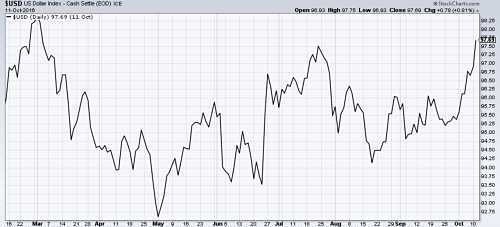






by Raul de Frutos on OCTOBER 13, 2016
Financial markets are beginning to believe the Federal Reserve is finally serious about increasing interest rates.
At least, that’s the simplest explanation for rising treasury yields and the U.S. dollar index, which measures the greenback vs. a basket of major currencies, hitting the highest level in seven months.

While the Fed has repeatedly pronounced its intentions to raise rates, markets took those announcements with a grain of salt, pricing in a lower future rate than what the Fed was promising.
Fed Turns Hawkish
However, since October, the 10-year Treasury yield has risen significantly as markets now see a 67% chance of a rate hike in the December meeting. Higher interest rates make the dollar more attractive to yield-seeking investors. Moreover, the dollar rose as most other major world currencies slid, particularly the British pound, which was depressed by Brexit concerns.
A rising dollar has a negative impact on metal prices. Metals are priced in dollars and when the value of the dollar rises, it takes more more of them to buy metals. Another reason is that when the value of the dollar rises, foreign buyers have less buying power, typically causing demand for metals to shrink.

This is particularly true in the case of gold and something we mentioned in September. Recently, gold prices fell to a four-month low as the dollar rose.
The dollar is not the only thing that moves metal prices but it is important. If the Fed raises rates this year that would likely strengthen the dollar, adding pressure to metal prices. On the other hand, if future Fed decisions disappoint, that would weaken the dollar, having a bullish effect on metal prices.
For queries, please contact Lemon Zhao at lemonzhao@smm.cn
For more information on how to access our research reports, please email service.en@smm.cn